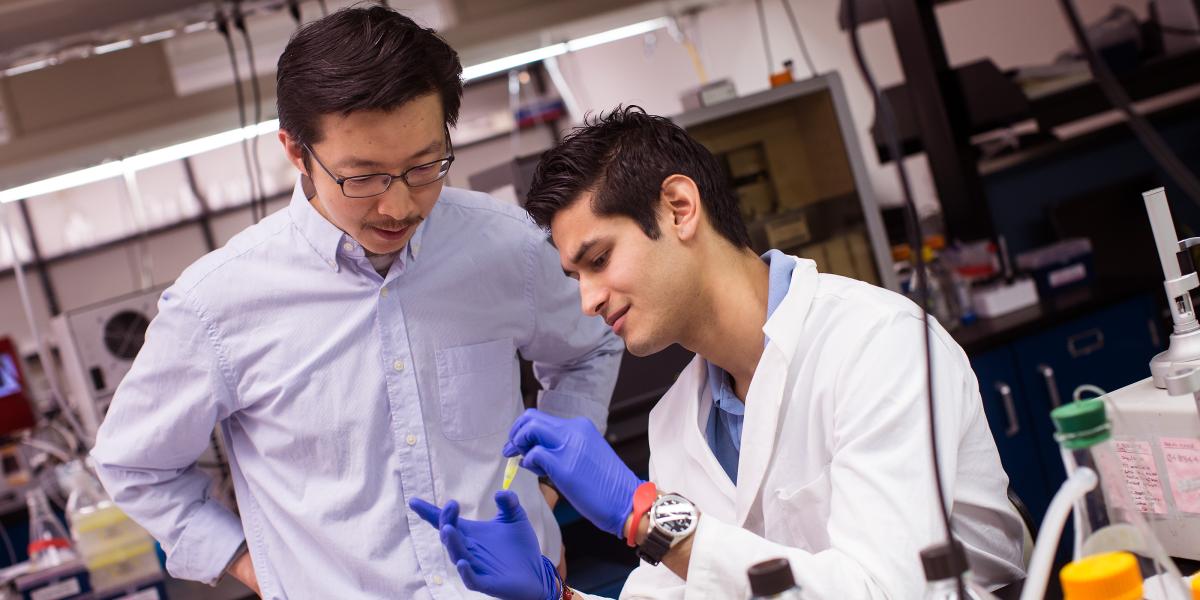Finally, the ‘How’ of ALS
If gene mutations were people, the mutation commonly found on a gene called C9ORF72 would be a notorious criminal. About two years ago, researchers first linked this mutation to the fatal, muscle-wasting disease amyotrophic lateral sclerosis (ALS)—Lou Gehrig’s disease. Since then, the mutation has been implicated in an ever-expanding list of ailments including Alzheimer’s disease, frontotemporal dementia and Huntington’s disease.
But, like detectives without a murder weapon, researchers haven’t understood how the C9ORF72 mutation derails normal cell functions. Now, Jiou Wang, PhD, an assistant professor in Biochemistry and Molecular Biology, and colleagues may have an answer. In a study focused on ALS and recently published in Nature, the team reports discovering a cascade of molecular events from mutation to pathology, potentially opening avenues to treat the disease’s root cause, not merely its symptoms. In recognition of this finding, Wang was awarded the 2014 Shikani/El Hibri Prize for Discovery & Innovation.
Like all genes, C9ORF72 consists of a sequence of bases (represented by letters) within a larger strand of DNA. A normal C9ORF72 gene contains a string of six letters, GGGGCC, which may be repeated a few times. In its mutated counterpart, this sequence repeats dozens to tens of thousands of times. Yet the familiar mutation story—alter a gene, alter the protein it codes for—doesn’t necessarily apply, as this region doesn’t code for a protein. Still, Wang’s team thought the repeats must be up to something. It took two years to confirm this hunch.
Step one in the team’s process was to create artificial DNA sequences with GGGGCC repeats. In these regions, the two strands of DNA pulled apart. One side folded over itself to form G-quadruplexes, stacks of square-shaped molecules that resemble a miniature, low-rise building. Meanwhile, the other side formed rare, long-lasting bonds with RNA, called R-loops.
In cells taken from patients, this bulbous, hybrid RNA-DNA crippled the machinery used to make standard RNA, which acts as a template for protein production. It’s as if the machinery hit “a series of speed bumps or the occasional roadblock,” says Wang (above left, with ScM student Tushar Chakravarty). Rather than creating one long RNA strand, the machinery produced many stunted ones. Worse still, these mini-strands attracted and diverted proteins that would otherwise be performing important cellular functions. When the team compiled a list of 280 proteins waylaid by this “toxic RNA,” a protein called nucleolin stood out as highly susceptible.
The team was onto something big. In healthy cells, nucleolin is concentrated in the nucleolus, a chamber within the nucleus where protein assembly begins. But in the cells of ALS patients, nucleolin is widely dispersed throughout the entire nucleus. Though the details aren’t clear yet, this dispersion puts stress on cells, sometimes causing their death. And it’s cell death that manifests in ALS patients as progressive movement problems. In short, by focusing on the structure of the C9ORF72 mutation, the team had found a probable root cause for ALS.
There’s much more to study. But Wang and his colleagues are eager to put their insights to use developing therapies. And they’re hopeful that, as researchers study over 30 other diseases linked to similar repeat regions, the basic process they’ve discovered will prove to be a “smoking gun” many times over.
